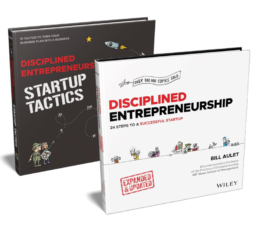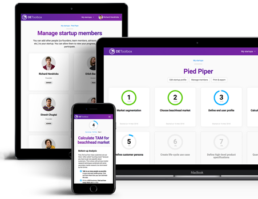Step 7
High-Level Product Specifications
Visually sketching out your product will allow your team and your potential customers to converge around an understanding of what the product is and how it benefits customers.
Staying at a high level, without too many details or a physical prototype, allows for rapid revision without investing too much time and resources this early in the process of creating your new venture. Building a visual representation of the product will likely be harder than you think, but will get everyone on the same page, which will prove extremely valuable going forward. Don’t build the product yet.
Videos
Worksheets
Examples
Content will be published as it becomes available.
Topics
Process Guide
“Finally,” you say, “now we can start to talk about the product!” Yes, now is the time. Why did I wait so long? Simple: I wanted you to stay open-minded. It was important that you be in full “inquiry mode” and not be in “advocacy mode.” Staying in inquiry mode significantly increases the odds that you will design a product your target customer loves and gets optimal value from.
In this step, you will build a High-Level Product Specification and ultimately a first draft brochure (which can be physical and/or digital, but the concept and content are essentially the same). This achieves the following important objectives:
- Drives a common understanding, on the team and beyond, of what product the company is thinking of producing. It is more common than not where team members have different ideas of what product they are aspiring to develop. This process forces explicit alignment and often surprises the team to see the level of misalignment they had before the exercise.
- Creates a focus on benefits rather than features and functions. Teams, especially technical teams, often start to get into feature wars with competitors and lose focus on the customer, who only sees the benefits (or lack thereof) that a feature provides. This exercise will keep the emphasis on benefits.
- Begins the process of prioritizing which benefits are more important than others. You’ll focus not just on your messaging but also on the product design/development and business model/pricing.
- Gives you something concrete to discuss and iterate on with the Persona (and later, other customers) while staying in “inquiry mode.” It is very easy to change a brochure as opposed to a prototype because brochures don’t take much time to develop, so you’re much less invested and attached to it than a prototype. Don’t let the “IKEA effect” blind you to what the customer really wants.
Start by completing the Visual Representation of Product worksheet, keeping in mind the following attributes of an effective High-Level Product Specification:
- Visual: If it is hardware, this is easy and surprisingly clarifying. For software, use a series of simulated screenshots to form a storyboard that shows how someone would use the product.
- Focus on benefits: Focus on the benefits and not the technology or functionality. In particular, focus on the benefits that are related to the Persona’s top three priorities, with a special focus on the top priority. Benefits are what matter to a savvy customer. Be clear on the value proposition this product has for the end user.
- High level: Don’t include too much detail! Just enough to show high-level functionality that will drive the benefits.
- Hits the spot: Make sure the product specification resonates deeply with the Persona and other customers in the target End User Profile group. Conversely, don’t be influenced by people outside your Beachhead Market, because they won’t help you achieve a dominant market share in your beachhead.
- Flexible: Make sure your product specification builds in the ability to iterate with the Persona about key features, functions, and benefits. Some people make multiple versions and show them side by side to the Persona. Listen to what the Persona says, and always be willing to change what you have done. A wise man once said, “Listening is the willingness to change.” Don’t ignore your Persona’s feedback just because you think the brochure is great.
Next, complete the Product Alignment with Persona worksheet. Does your high-level specification line up with your Persona’s key priorities? Is it ready for review with your Persona? And once it is, what feedback does your Persona provide, and how will you revise the specification in response?
Remember that the Persona’s job is not to design the product for you, but to provide feedback on whether the benefits are useful. As I cover in Step 23, Show That “The Dogs Will Eat the Dog Food,” the ultimate test will come later when it comes time for your customers to pay for your product.
High-Level Landing Page, Product Brochure or Storyboard
Once you have iterated on your High-Level Product Specification, you may want to build a landing page, a storyboard, or a trifold brochure that more clearly outlines the benefits your product provides. Some people will wait to make a brochure until they have iterated the specification with other customers in Step 9, Identify Your Next 10 Customers, but others find a brochure useful at this stage.
A good brochure should have the following items:
- First draft of company name and tagline.
- Name of product and tagline.
- Image or picture of the product so it is clear what it is.
- Clearly identified benefits aligned with the Persona’s #1 priority (don’t be subtle—it should come out in the taglines and even maybe the name of your product).
- Two additional benefits (if appropriate), aligned with the second and third priorities of the Persona, that don’t dilute the impact of the first benefit.
- Provide a sense of the magnitude of the benefit to be expected by the end user. Use your work from Step 6, Full Life Cycle Use Case.
- Some other information might be relevant, but always be diligent about not diluting your main message—if you say too much, you say nothing in particular.
- Have a clear call to action.
- Everything should be fully aligned with the customer’s priorities and will resonate with the customer in all elements (e.g., names, taglines, pictures, benefits emphasized, fonts, colors, word choice, language, references, and call to action).
There are great individuals and agencies you can hire to design your landing pages, brochures, or storyboards but do not overpay. Focus on high-level content not too many details and make your product description look nice but not overdesigned. You are not expected to become an expert in design or User Interface experience. You want to think through the content carefully from a logical standpoint and be concise in how it compellingly addresses the Persona’s priorities. That way, if you choose to delegate or outsource the design, you can give them clear direction and not settle for an inferior brochure.
Historically, the brochure is the most commonly and widely given elevator pitch about your product because it can be done when you are not in the room and even when you are sleeping. It makes consistent messaging possible and scalable, so don’t just downplay it as “marketing hype.” It really matters.
You also have to back it up with a great product, but that is coming. First, you have to make sure you are building the right product for your customer, and this process helps to communicate that to all sides.
Books
Content will be published as it becomes available.
Other Resources
Content will be published as it becomes available.
The Disciplined Entrepreneurship Toolbox
Stay ahead by using the 24 steps together with your team, mentors, and investors.
The books
This methodology with 24 steps and 15 tactics was created at MIT to help you translate your technology or idea into innovative new products. The books were designed for first-time and repeat entrepreneurs so that they can build great ventures.

